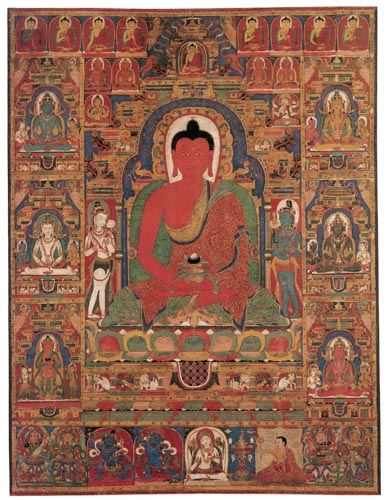| 29. Amitayus
|

29.
Amitayus
Central Tibet, 13th century
Distemper on cloth
79.5 x 60.5 cm (311/4 x 237/8 in.)
Private collection
|
This beautiful painting represents the Buddha Amitayus (Of Infinite Life), a deity associated with rites that would
ensure a long life. Amitayus is closely connected with Amitabha, the Buddha of infinite Light, and in some texts
the two names are used interchangeably for the same deity. Here, Amitayus is seated in a meditative posture, his
hands cradling a vase (kalasha) containing the elixir of immortality (amrita) and leaves of the
ashoka tree, which symbolize "a long life without (a) the misery (shoka) of
disease."1 The kalasha is surmounted by an alms bowl; Tucci notes that
Amitayus is sometimes described as
holding a "vase for alms," and perhaps that is what is intended in this
painting.2 Works such as the
Sukhavativyuha and the Saddharma Pundarika describe Amitayus/Amitabha preaching the
dharma in an
exquisitely rarefied realm known as Sukhavati Paradise.3 There are no specific references to this paradise in the
painting, but Tucci notes that "besides being a heaven, [Sukhavati] remains one of the numberless worlds in
infinite space, where a Buddha analogous to the historical Buddha preaches the Law; he [Amitayus]
... is accordingly represented under the bodhi tree."4 Here, the leaves and branches of the
bodhi tree can be seen
behind the spire of Amitayus's temple.
The enthroned deity is flanked by two standing attendants, the bodhisattvas Padmapani (on his right) and
Mahastharnaprapta (a form of Vajrapani, on his left). Amitayus appears within the trilobe arch of a temple
whose superstructure (shikhara) rises above the attendant bodhisattvas in receding tiers, and is then
surmounted by a shrine enclosing a Buddha in bhumisparsha mudra, the earth-touching gesture, a
reference to the historical Buddha's enlightenment. Streamers arranged in an even scrolling pattern fall from a
parasol at the top of the shikhara, and cloudborne attendants bear a parasol and a banner, symbols heralding
the attainment of enlightenment. The painting is unusual in the iconography of its side registers, each of which portrays three enthroned Buddhas within temples. Of the
six, five hold the vase of immortal elixir, Amitayus's identifying attribute, and
bear the colors associated with the five Tathagatas: green (Amoghasiddhi), white
(Vairochana), yellow (Ratnasambhava), blue (Akshobhya), and red (Amitabha). The sixth Buddha stands at the lower left holding an alms
bowl. Four seated figures of Amitayus flank the spire of the temple, as do images of Avalokiteshvara (below them,
on the left) and Ushnishavijaya, on the right.
In the top register are eight Buddhas, perhaps the seven Buddhas of the Past and Maitreya, the Future
Buddha.5 In the bottom register (far left and far right) are the Four Guardian Kings (caturmaharajas), each
associated with one of the four cardinal points of the compass: Dhrtarashtra holding a stringed instrument
(east), Virudhaka holding a sword (south), Virupaksha with a serpent and a stupa (west), and Vaishravana with a staff
and mongoose (north). The deities Achala (with sword and noose), a wrathful Vajrapani (with bell and
vajra), and Tara
also appear in the bottom register, along with the consecrating monk, a mustached figure drawn with great
sensitivity and seated in front of a white, gold patterned cloth. He holds the stem of an incense burner, fashioned in
the shape of a lotus bud, from which smoke is rising. At the monk's right a low table supports a
stupa whose plinth
bears crossed fly whisks flanked by offering lamps and other implements associated with ritual practice.
Little is known about the worship of Amitayus in Tibet, although it is likely that all Buddhists would have
venerated this deity to promote health and prolong life. A late-twelfth-century painting in the Los Angeles County
Museum of Art is a portrayal of Amitayus accompanied by an inscription which states
that the painting was
dedicated during a long life attainment ceremony performed
by Chokyi Gyaltsen (d. 1189?).6 Tucci notes a hymn to Amitayus written by the Sakya hierarch
Phakpa (1235-1280) in 1258, but there is no reason to associate this work
specifically with the Sakya order.7 A thirteenth-century date is proffered for this painting, although it retains
features seen in twelfth-century works, such as the cloud-borne deities flanking the top of the
shikhara (compare with those in the twelfth-century Ushnishavijaya, cat. no. 6; and in the twelfth-century
One-Thousand-Armed Avalokiteshvara, cat. no.12), and the similarly rendered standing attendants (compare those in the twelfth-century
Buddha, cat. no.15; and in the ca. 1200 Buddhist Hierarch,
cat. no. 17). Despite these earlier elements, the painting shares a wealth of features with other thirteenth-century
works. Amitayus shares with the early-thirteenth century Amitabha (cat. no. 23b) an elegant, similarly drawn head
and torso. The coloration and drawing of their respective lotus petals are also similar, with curling
leaves that resemble frothy waves. The lotus petals also resemble those in the
thirteenth-century Amoghasiddhi
(cat. no. 25) and Maitreya (cat. no. 24). Amitayus's robes, an iconographic feature associated with his
nirmanakaya
(emanational body), or earthly form, show an understanding of and appreciation for Chinese silks.
Marked with gold roundels containing flowers, the red upper robe is arranged in loose, rich patterns, sometimes
folded to expose the underside of a fabric in contrasting but complementary colors and designs. The painting
attests to the existence of Amitayus worship in the central regions of Tibet in the thirteenth century, and future
studies may associate this work more closely with specific developments in central Tibet at that time.
JCS
1. Tucci, Spiti and Kunavar, 1988, p.
xxxvii. [back]
2. Tucci 1949, vol. 2, p. 350. [back]
3. Ibid., vol. 2, pp. 349-50. [back]
4. Ibid., vol. 2, p. 350. [back]
5. The names of the seven Buddhas differ in various accounts, but the following is a frequently occurring roster: Vipashyin,
Shikhin, Vishvabhuk, Krakucchanda, Kakutsunda, Kanakamuni, and Kashyapa. [back]
6. Pal 1983, pp. 134, 259. [back]
7. Tucci 1949, vol. 2, p. 350. [back]
|
